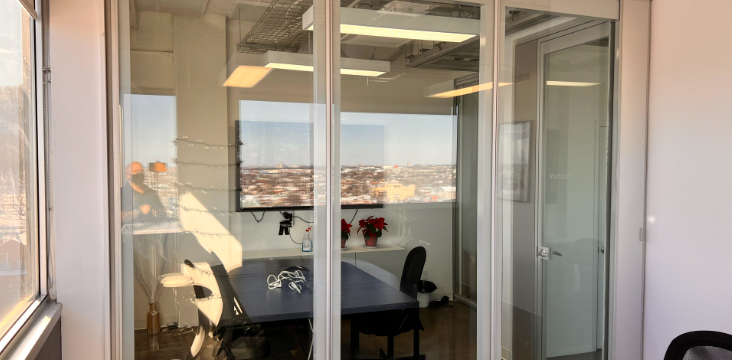It is all about light and always will be.
Interior glass wall systems (demountable and moveable) came into being and subsequently evolved (and continue to evolve) because of the demand for more interior light and the associated benefits. Demountable (fixed in place) were first but they soon evolved into track & trolley mounted movable wall systems which added the additional benefits of flexibility, aesthetics, and sound control.
Movable/Operable glass walls have truly emerged as a game changer. They transformed the way we perceive and utilize space in both residential and commercial applications. Since they are dynamic – they move and do something – they are both functional and aesthetically pleasing, allowing for the creation of flexible, adaptable spaces that can be quickly modified to suit the needs of the occupants. And natural light permeates and fills the area creating a welcoming and inviting atmosphere. Natural light. Visibility. Security
Because they move either manually or by the push of a button, flexibility is available. Spaces can be expanded, divided, or reconfigured at a moment’s notice. And because they are made using glass – the light follows. A sense of confinement often felt if solid moveable walls are used is eliminated using glass thus creating openness and connectivity. Unobstructed views, line of sight capability (important for occupant safety), visual & emotional connection with co-workers, an increase in occupant productivity, physical well-being, a decrease in associate absenteeism is just a few of the documented benefits of glass wall systems.
A major innovation was the improvement in movable glass wall system acoustics. Initially moveable glass walls were primarily single panes of ½” glass. But now dual pane systems separated by an airspace provide STC values up to 51 – certainly satisfactory for most applications needing sound separation and typically equal to the most used solid movable wall systems. Increased sound control (higher STC values) equal to or even exceeding solid movable wall systems is soon.
And if you require privacy, glass that can be rendered opaque by the touch of a button is possible on dual pane design systems. Or an option for internal blind systems is available.
Aesthetic considerations such as standard or customized anodizing of aluminum framing components, colorful powder coating options, personalization using designer glass, custom design etching, glass marker boards etc.
By using natural light energy costs are reduced especially if a laminated or “insulated” glass is part of the design.
Glass is easier to maintain and clean as compared to solid partitions with vinyls, fabrics and carpets as the standards and often needing repair and replacement.
Following is a summary of the three types of wall systems that are most applicable for nonresidential applications.
Types of Glass Walls:
Aluminum Framed Dual Pane:
- Two panes of sometimes different thicknesses of glass separated by an airspace creating a 3 to 4” thick panel.
- Available as single or paired.
- Manual, automatic or semi-automatic operation – singles only.
- Top supported c/w trolley system suitable for application. – no floor track.
- Right angle or switch and curved track: parallel, perpendicular, or remote single stacking. Center stacking for paired systems.
- Acoustic Seals: Top, bottom, Vertical (astragals). Sealing against fixed wall.
- Has STC values ranging from 43 to 51 depending on design, type of glass & panel thickness.
- Heights up to fourteen’ with special height considerations available (consult manufacturer), maximum forty-eight” wide.
Aluminum Framed Single Pane:
- One pane of glass (usually ½”).
- Single panel configuration only.
- Can be manual, automatic, or semi-automatic.
- Top supported c/w trolley system suitable for application. – no floor track.
- Right angle or switch and curve track. Parallel, Perpendicular or Remote stacking.
- Top and base seals. Astragals.
- STC values up to STC 35.
- Maximum height of ten.’ Maximum forty-eight” wide panels.
Frameless single pane:
- One pane of glass (usually ½”).
- Single or continuously hinged configurations
- Automatic or semi-automatic available.
- Top supported c/w trolley system suitable for application. – no floor track.
- Right angle or switch and curve track. Parallel, Perpendicular, Remote, or center stacking available.
- No acoustic seals.
- No appreciable sound control qualities.
- Maximum height of ten.’ 48” maximum panel width.
Accessories & Options.
- Pass Doors: Usually a “pivot panel final closure” located at either end of the partition is designed to function as a pass-through door providing egress (all models). A convertible panel can also be located anyplace within the run and function as a single or double pass door (framed and frameless single panel systems only). Or a conventional pass door, single only, can be used. (Framed dual pane only).
- Hinges – invisible or standard.
- Transitional Glass, Privacy Smartglass or Switchable Glass. Glass that can be interchanged between transparency and opaque by applying voltage.
- Many types of glass including: ½” clear and frosted (optional low iron). ½” laminated clear and frosted (optional low iron). ½” markerboard glass. Low Iron glass is known as extra-clear glass, does not have the greenish tint of clear glass and has increased visual clarity.
- Various finishes on rails/panel frames: including anodized & powder coated in several finishes.
- Rail /Frame shapes & dimensions: Vary in shape and dimensions based on system selected. Typically, 4 to 5”
- Various hardware options such as flush pulls, flush ring pulls, flush levers, locks. Panic bars, door closures, security can be provided by using locking foot bolts etc.
Moveable wall glass systems are a growing market with additional applications surfacing every day limited only by one’s imagination. There are potential applications in all markets: Commercial (training and meeting rooms), Education (Security needs require visibility especially in publicly accessible areas), Hospitality (Meeting rooms. Quickly set up meeting areas in hallway. Overflow areas adjacent to large ballrooms). Healthcare (Dining areas. Meeting & patient consultation areas).
Simply put: “More glass means more light” – and who does not want more light?





